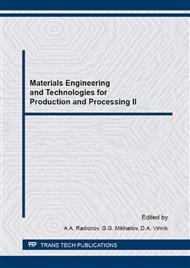p.345
p.352
p.360
p.364
p.371
p.377
p.383
p.392
p.397
Synthesis of Transition Metals Carbide Compounds in the Vacuum Arc Discharge Plasma
Abstract:
To implement the plasmochemical synthesis of transition metals (Ti, Zr, Mo, W) carbide compounds in a plasma flux of the vacuum arc the discharge carbonaceous working gas is infused. It is shown that the composition of the initial carbonaceous gas defines both the carbon output, and the nature and course of the carbide compounds formation chemical reaction. The composition analysis of the plasma flux in the course of the coating evaporation was carried out by means of the developed emissive spectral analyzer. The result shows that a considerable part of transition metals carbide phases has wide zones of homogeneity within which the change in the carbon content happens without the crystalline grid reorganization. The work reveals and analyzes the factors defining quality of the received carbide compounds (TiC, ZrC, MoC, WC) of refractory metals in a flux of metal plasma of the vacuum arc discharge.
Info:
Periodical:
Pages:
371-376
Citation:
Online since:
September 2016
Authors:
Price:
Сopyright:
© 2016 Trans Tech Publications Ltd. All Rights Reserved
Share:
Citation:


